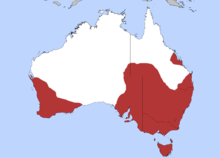Musk duck
| Musk duck | |
|---|---|
 |
|
| Female | |
| Scientific classification | |
| Kingdom: | Animalia |
| Phylum: | Chordata |
| Class: | Aves |
| Order: | Anseriformes |
| Family: | Anatidae |
| Subfamily: | Oxyurinae (but see text) |
| Genus: |
Biziura Stephens, 1824 |
| Species: | B. lobata |
| Binomial name | |
|
Biziura lobata (Shaw, 1796) |
|
 |
|
| Distribution of the musk duck | |
The musk duck (Biziura lobata) is a highly aquatic, stiff-tailed duck native to southern Australia. It is the only living member of the genus Biziura. An extinct relative, the New Zealand musk duck or de Lautour's duck (B. delautouri), once occurred on New Zealand, but is only known from prehistoric subfossil bones. It was about 8% longer than the living species, with a particularly large head.
This animal derives its common name from the peculiar musky odour it emanates during the breeding season. Musk ducks are moderately common through the Murray-Darling and Cooper Creek basins, and in the wetter, fertile areas in the south of the continent: the southwest corner of Western Australia, Victoria, and Tasmania.
Adult males are 60 to 70 cm (24 to 28 in) long and have a distinctive large, leathery lobe underneath the bill; females are 47 to 55 cm (19 to 22 in) long and unadorned. Their drab dark grey-brown, slightly pin-striped plumage is inconspicuous and does not differ between the sexes. This species weighs an average of 2,398 g (5.287 lb) in males and 1,551 g (3.419 lb) in females, with the smallest females weighing only 993 g (2.189 lb) and the largest males weighing up to 3,170 g (6.99 lb). On average, they are the second-heaviest diving duck in the world after the common eider, with male musk ducks actually being slightly heavier than male common eiders, but female eiders being rather larger than female musk ducks due to that species' lesser size sexual dimorphism. Musk ducks float very low in the water, almost like a cormorant, and the large, webbed feet are well back on the body. The ducklings are covered in dark brown down.
...
Wikipedia

